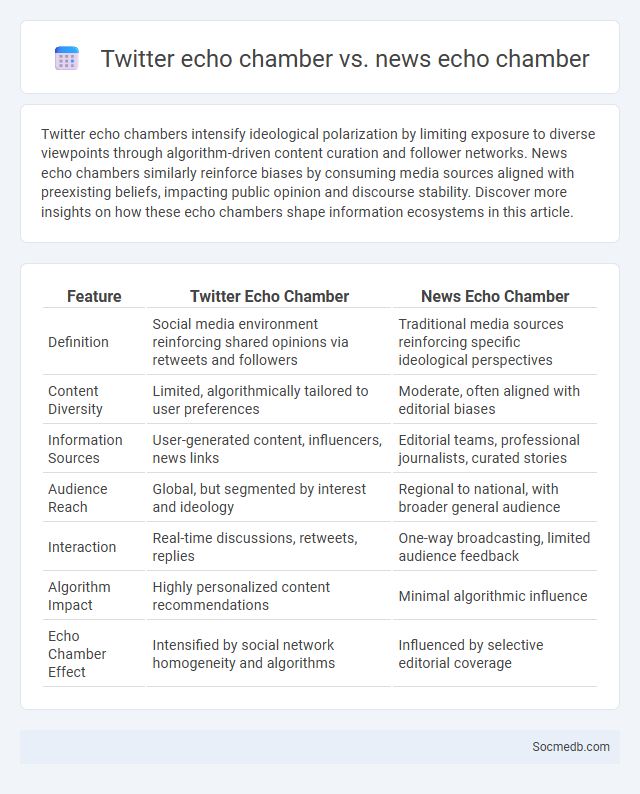
Photo illustration: Twitter echo chamber vs news echo chamber
Twitter echo chambers intensify ideological polarization by limiting exposure to diverse viewpoints through algorithm-driven content curation and follower networks. News echo chambers similarly reinforce biases by consuming media sources aligned with preexisting beliefs, impacting public opinion and discourse stability. Discover more insights on how these echo chambers shape information ecosystems in this article.
Table of Comparison
| Feature | Twitter Echo Chamber | News Echo Chamber |
|---|---|---|
| Definition | Social media environment reinforcing shared opinions via retweets and followers | Traditional media sources reinforcing specific ideological perspectives |
| Content Diversity | Limited, algorithmically tailored to user preferences | Moderate, often aligned with editorial biases |
| Information Sources | User-generated content, influencers, news links | Editorial teams, professional journalists, curated stories |
| Audience Reach | Global, but segmented by interest and ideology | Regional to national, with broader general audience |
| Interaction | Real-time discussions, retweets, replies | One-way broadcasting, limited audience feedback |
| Algorithm Impact | Highly personalized content recommendations | Minimal algorithmic influence |
| Echo Chamber Effect | Intensified by social network homogeneity and algorithms | Influenced by selective editorial coverage |
Understanding Echo Chambers: Definition and Impact
Echo chambers are digital environments where users are exposed predominantly to information and opinions that reinforce their existing beliefs, limiting exposure to diverse perspectives. This phenomenon intensifies polarization and can distort public discourse by amplifying misinformation and reducing critical engagement. Algorithms on social media platforms often contribute to echo chambers by curating content that aligns with users' preferences, further entrenching biased viewpoints.
The Anatomy of a Twitter Echo Chamber
Twitter echo chambers form when users primarily engage with like-minded accounts, reinforcing their own opinions and limiting exposure to diverse perspectives. Algorithms amplify this effect by prioritizing content similar to previous interactions, creating a feedback loop that narrows Your information intake. Understanding the anatomy of these echo chambers helps you recognize biased content streams and seek more balanced viewpoints.
News Media Echo Chambers: How They Form
News media echo chambers form when individuals consistently engage with social media content that aligns with their existing beliefs, reinforcing preexisting opinions and limiting exposure to diverse perspectives. Algorithms prioritize personalized content based on user behavior, promoting information bubbles that strengthen ideological homogeneity. This selective exposure intensifies polarization and diminishes critical thinking by isolating users within self-reinforcing news environments.
Twitter vs News: Comparing Echo Chamber Dynamics
Twitter often amplifies echo chamber dynamics by enabling users to curate feeds that reinforce their views through retweets and algorithmic recommendations. News media, while sometimes subject to bias, typically presents more diverse perspectives due to editorial standards and journalistic practices. Your exposure to balanced viewpoints depends largely on active efforts to diversify information sources beyond Twitter's personalized environment.
Algorithms and the Spread of Echo Chambers
Social media algorithms prioritize content that aligns with users' existing beliefs, amplifying exposure to similar viewpoints and reinforcing confirmation bias. This selective exposure fosters the creation of echo chambers, where diverse perspectives are minimized, and polarization intensifies. Data from platforms like Facebook and Twitter reveal how algorithmic curation increases the circulation of homogeneous content, shaping public opinion and discourse.
User Behavior and Participation in Echo Chambers
User behavior on social media often leads to active participation in echo chambers, where individuals engage primarily with like-minded content and opinions. This selective exposure reinforces existing beliefs, creating homogenous communities that limit diverse perspectives and critical discussions. Algorithms designed to maximize user engagement further intensify echo chamber effects by promoting content aligned with users' past interactions and preferences.
Misinformation Amplification in Social vs News Echo Chambers
Social media platforms accelerate misinformation amplification through algorithm-driven echo chambers that reinforce users' existing beliefs, limiting exposure to diverse perspectives. News echo chambers, while similar, often feature curated content from established sources, which can constrain but also moderate misinformation spread. Your engagement in these digital environments influences the extent and nature of misinformation you encounter, underscoring the need for critical evaluation of shared content.
Breaking the Bubble: Strategies to Disrupt Echo Chambers
Breaking the bubble of social media echo chambers requires intentional exposure to diverse perspectives through varied content sources such as different news outlets, interest groups, and cultural viewpoints. Engaging critically with opposing opinions and using platform tools to follow contrasting voices can expand Your understanding and reduce confirmation bias. Implementing these strategies fosters a more balanced online experience and encourages meaningful dialogue beyond algorithm-driven silos.
Psychological Effects of Living in Echo Chambers
Living in social media echo chambers can intensify cognitive biases and reinforce polarized beliefs, leading to distorted perceptions of reality. The continuous exposure to homogenous viewpoints limits critical thinking and increases susceptibility to misinformation, impacting mental health by fostering anxiety and social isolation. These psychological effects contribute to decreased empathy and heightened group identity, fueling societal division.
Future Trends: Evolving Echo Chambers in the Digital Age
Future trends in social media reveal increasingly sophisticated echo chambers driven by advanced algorithms tailoring content to Your preferences, reinforcing existing beliefs and limiting exposure to diverse perspectives. Artificial intelligence and machine learning will create hyper-personalized feeds that deepen ideological segregation, impacting public discourse and social polarization. Understanding these evolving echo chambers is crucial for developing strategies to promote digital literacy and foster open, balanced online communities.
 socmedb.com
socmedb.com